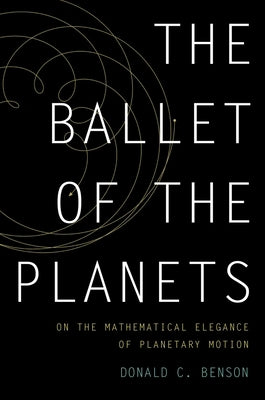1
/
of
1
Oxford University Press, USA
The Ballet of the Planets: A Mathematician's Musings on the Elegance of Planetary Motion
The Ballet of the Planets: A Mathematician's Musings on the Elegance of Planetary Motion
Regular price
$61.00 USD
Regular price
Sale price
$61.00 USD
Shipping calculated at checkout.
Quantity
Couldn't load pickup availability
The Ballet of the Planets unravels the beautiful mystery of planetary motion, revealing how our understanding of astronomy evolved from Archimedes and Ptolemy to Copernicus, Kepler, and Newton. Mathematician Donald Benson shows that ancient theories of planetary motion were based on the
assumptions that the Earth was the center of the universe and the planets moved in a uniform circular motion. Since ancient astronomers noted that occasionally a planet would exhibit retrograde motion--would seem to reverse its direction and move briefly westward--they concluded that the planets
moved in epicyclic curves, circles with smaller interior loops, similar to the patterns of a child's Spirograph. With the coming of the Copernican revolution, the retrograde motion was seen to be apparent rather than real, leading to the idea that the planets moved in ellipses. This laid the ground
for Newton's great achievement--integrating the concepts of astronomy and mechanics--which revealed not only how the planets moved, but also why. Throughout, Benson focuses on naked-eye astronomy, which makes it easy for the novice to grasp the work of these pioneers of astronomy.
Author: Donald Benson
Publisher: Oxford University Press, USA
Published: 05/29/2012
Pages: 192
Binding Type: Hardcover
Weight: 0.85lbs
Size: 9.30h x 6.00w x 0.90d
ISBN: 9780199891009
Review Citation(s):
Library Journal 06/01/2012 pg. 121
Choice 01/01/2013
assumptions that the Earth was the center of the universe and the planets moved in a uniform circular motion. Since ancient astronomers noted that occasionally a planet would exhibit retrograde motion--would seem to reverse its direction and move briefly westward--they concluded that the planets
moved in epicyclic curves, circles with smaller interior loops, similar to the patterns of a child's Spirograph. With the coming of the Copernican revolution, the retrograde motion was seen to be apparent rather than real, leading to the idea that the planets moved in ellipses. This laid the ground
for Newton's great achievement--integrating the concepts of astronomy and mechanics--which revealed not only how the planets moved, but also why. Throughout, Benson focuses on naked-eye astronomy, which makes it easy for the novice to grasp the work of these pioneers of astronomy.
Author: Donald Benson
Publisher: Oxford University Press, USA
Published: 05/29/2012
Pages: 192
Binding Type: Hardcover
Weight: 0.85lbs
Size: 9.30h x 6.00w x 0.90d
ISBN: 9780199891009
Review Citation(s):
Library Journal 06/01/2012 pg. 121
Choice 01/01/2013
About the Author
Donald C. Benson is Emeritus Professor of Mathematics at the University of California, Davis, and the author of A Smoother Pebble and The Moment of Proof.
This title is not returnable
Share


